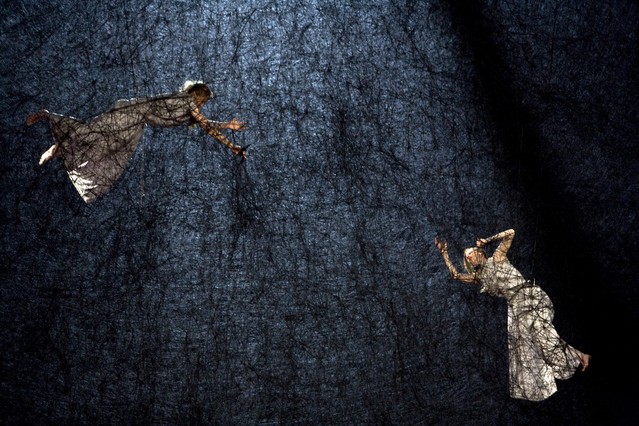
Charlotte Hellekant & Barbara Hannigan in Matsukaze, Photo: Bernd Uhlig/LaMonnale/De Munt via Bloomberg
Read what Hannah Duebgen, librettist from Toshio Hosokawa’s Matsukaze, says about Hosokawa’s connection to nature. Re-posted from Talea’s blog from January 2012.
“When I first met Toshio Hosokawa, two things about him struck me immediately: On the one hand his life in two cultures, the Japanese and the Western world, and, along with it, his very modern lifestyle: long distance flights, jet lags and the constant swapping between languages are part of his professional routine, while I also sensed in him a deep affection for nature in general and the Japanese landscape in particular.
Whoever has had the chance to be shown around Japan by him, has seen the joy and devotion with which Toshio points at a wild waterfall, a flower about to blossom or the stone bed in a Japanese garden, begins to understand where the source of his energy and inspiration lies. For Toshio, his profound attachment to nature goes far beyond a mere appreciation of its soothing beauty and recreational value, and is instead fueled by the Buddhist belief that we human beings are all part of a greater whole, a unity that becomes sentient in the nature surrounding us. Just as every breath we take unites us with the air around us, brings oxygen into our bodies which also ensures the life of plants and animals, we thus become, each time we take a breath, part of that greater entity called nature, or even the universe.
This idea of breath as a passageway linking human beings to nature resonates strongly in Toshio’s musical aesthetics. Many of his compositions begin with an ascending sound, rising – like a breath – slowly out of silence into being, then reaching a peak point before returning into silence again. During that process, silence can make itself felt as that which tacitly surrounds us and is gradually inhaled by the rising sound, a sound which gains momentum as it incorporates more and more silence… When talking about his music, Toshio likes to compare the breathing gestures in his works to a calligraphic line that equally arises out of nothing – the blank page – into something, a black brushstroke, before returning into nothing again.
It is in this sense that most of his works are horizontally conceived and bear a natural, organic flow. They play with classical Western modes of musical progression like contrast, counterpoint or harmonic modulations, and yet never lose those underlying breathing gestures which make Toshio’s music unique. Many of his pieces carry names referring to nature, ‘Landscape I, II, III’ being among the most obvious examples, other works allude to the process of ‘Blossoming’ or ‘Dawn’, and even ‘Matsukaze’ the Japanese title of the opera for which I wrote the libretto, refers to a natural phenomenon: matsu-kaze, which in Japanese can mean ‘wind in the pines’ as well as ‘pining wind’.
In all of his works, Toshio remains a wanderer through cultures, combining traditional Western instruments with his particular, Eastern musical aesthetics. And it may well be that combination which fascinates many listeners – Eastern and Western – in Toshio’s work: His use of music as a way of bringing us back to that which unites us all.”
Hannah Duebgen,
January 2012
